Orest Kupyn
S3OD: Towards Generalizable Salient Object Detection with Synthetic Data
Oct 24, 2025Abstract:Salient object detection exemplifies data-bounded tasks where expensive pixel-precise annotations force separate model training for related subtasks like DIS and HR-SOD. We present a method that dramatically improves generalization through large-scale synthetic data generation and ambiguity-aware architecture. We introduce S3OD, a dataset of over 139,000 high-resolution images created through our multi-modal diffusion pipeline that extracts labels from diffusion and DINO-v3 features. The iterative generation framework prioritizes challenging categories based on model performance. We propose a streamlined multi-mask decoder that naturally handles the inherent ambiguity in salient object detection by predicting multiple valid interpretations. Models trained solely on synthetic data achieve 20-50% error reduction in cross-dataset generalization, while fine-tuned versions reach state-of-the-art performance across DIS and HR-SOD benchmarks.
Epipolar Geometry Improves Video Generation Models
Oct 24, 2025Abstract:Video generation models have progressed tremendously through large latent diffusion transformers trained with rectified flow techniques. Yet these models still struggle with geometric inconsistencies, unstable motion, and visual artifacts that break the illusion of realistic 3D scenes. 3D-consistent video generation could significantly impact numerous downstream applications in generation and reconstruction tasks. We explore how epipolar geometry constraints improve modern video diffusion models. Despite massive training data, these models fail to capture fundamental geometric principles underlying visual content. We align diffusion models using pairwise epipolar geometry constraints via preference-based optimization, directly addressing unstable camera trajectories and geometric artifacts through mathematically principled geometric enforcement. Our approach efficiently enforces geometric principles without requiring end-to-end differentiability. Evaluation demonstrates that classical geometric constraints provide more stable optimization signals than modern learned metrics, which produce noisy targets that compromise alignment quality. Training on static scenes with dynamic cameras ensures high-quality measurements while the model generalizes effectively to diverse dynamic content. By bridging data-driven deep learning with classical geometric computer vision, we present a practical method for generating spatially consistent videos without compromising visual quality.
VGGHeads: A Large-Scale Synthetic Dataset for 3D Human Heads
Jul 25, 2024Abstract:Human head detection, keypoint estimation, and 3D head model fitting are important tasks with many applications. However, traditional real-world datasets often suffer from bias, privacy, and ethical concerns, and they have been recorded in laboratory environments, which makes it difficult for trained models to generalize. Here, we introduce VGGHeads -- a large scale synthetic dataset generated with diffusion models for human head detection and 3D mesh estimation. Our dataset comprises over 1 million high-resolution images, each annotated with detailed 3D head meshes, facial landmarks, and bounding boxes. Using this dataset we introduce a new model architecture capable of simultaneous heads detection and head meshes reconstruction from a single image in a single step. Through extensive experimental evaluations, we demonstrate that models trained on our synthetic data achieve strong performance on real images. Furthermore, the versatility of our dataset makes it applicable across a broad spectrum of tasks, offering a general and comprehensive representation of human heads. Additionally, we provide detailed information about the synthetic data generation pipeline, enabling it to be re-used for other tasks and domains.
Dataset Enhancement with Instance-Level Augmentations
Jun 12, 2024



Abstract:We present a method for expanding a dataset by incorporating knowledge from the wide distribution of pre-trained latent diffusion models. Data augmentations typically incorporate inductive biases about the image formation process into the training (e.g. translation, scaling, colour changes, etc.). Here, we go beyond simple pixel transformations and introduce the concept of instance-level data augmentation by repainting parts of the image at the level of object instances. The method combines a conditional diffusion model with depth and edge maps control conditioning to seamlessly repaint individual objects inside the scene, being applicable to any segmentation or detection dataset. Used as a data augmentation method, it improves the performance and generalization of the state-of-the-art salient object detection, semantic segmentation and object detection models. By redrawing all privacy-sensitive instances (people, license plates, etc.), the method is also applicable for data anonymization. We also release fully synthetic and anonymized expansions for popular datasets: COCO, Pascal VOC and DUTS.
DAD-3DHeads: A Large-scale Dense, Accurate and Diverse Dataset for 3D Head Alignment from a Single Image
Apr 11, 2022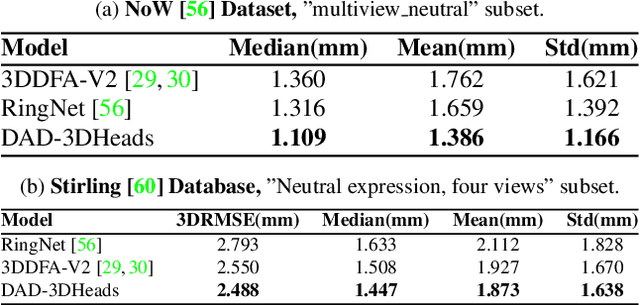
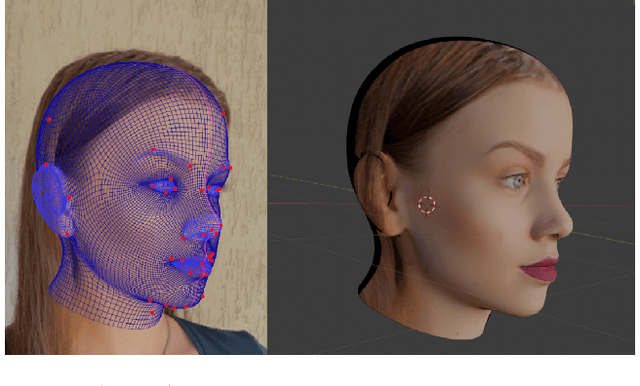
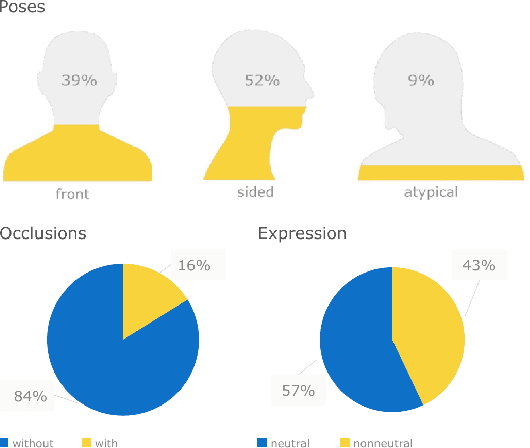
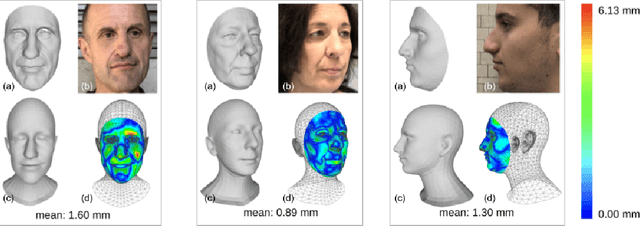
Abstract:We present DAD-3DHeads, a dense and diverse large-scale dataset, and a robust model for 3D Dense Head Alignment in the wild. It contains annotations of over 3.5K landmarks that accurately represent 3D head shape compared to the ground-truth scans. The data-driven model, DAD-3DNet, trained on our dataset, learns shape, expression, and pose parameters, and performs 3D reconstruction of a FLAME mesh. The model also incorporates a landmark prediction branch to take advantage of rich supervision and co-training of multiple related tasks. Experimentally, DAD-3DNet outperforms or is comparable to the state-of-the-art models in (i) 3D Head Pose Estimation on AFLW2000-3D and BIWI, (ii) 3D Face Shape Reconstruction on NoW and Feng, and (iii) 3D Dense Head Alignment and 3D Landmarks Estimation on DAD-3DHeads dataset. Finally, the diversity of DAD-3DHeads in camera angles, facial expressions, and occlusions enables a benchmark to study in-the-wild generalization and robustness to distribution shifts. The dataset webpage is https://p.farm/research/dad-3dheads.
FEAR: Fast, Efficient, Accurate and Robust Visual Tracker
Dec 15, 2021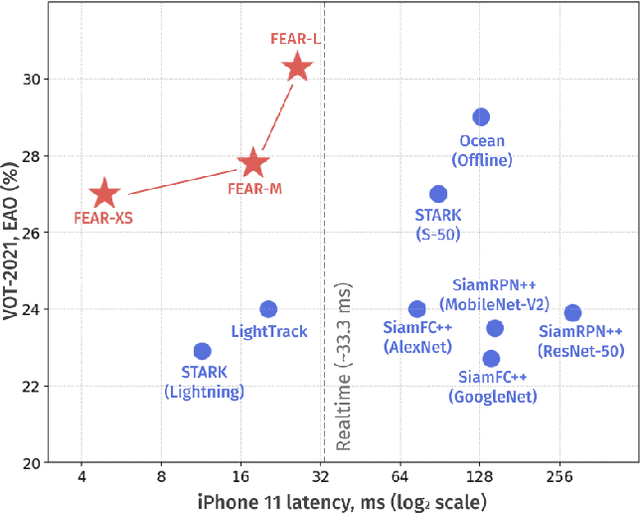

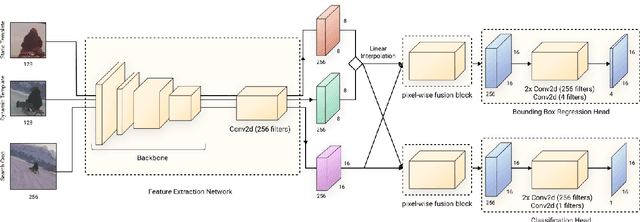

Abstract:We present FEAR, a novel, fast, efficient, accurate, and robust Siamese visual tracker. We introduce an architecture block for object model adaption, called dual-template representation, and a pixel-wise fusion block to achieve extra flexibility and efficiency of the model. The dual-template module incorporates temporal information with only a single learnable parameter, while the pixel-wise fusion block encodes more discriminative features with fewer parameters compared to standard correlation modules. By plugging-in sophisticated backbones with the novel modules, FEAR-M and FEAR-L trackers surpass most Siamesetrackers on several academic benchmarks in both accuracy and efficiencies. Employed with the lightweight backbone, the optimized version FEAR-XS offers more than 10 times faster tracking than current Siamese trackers while maintaining near state-of-the-art results. FEAR-XS tracker is 2.4x smaller and 4.3x faster than LightTrack [62] with superior accuracy. In addition, we expand the definition of the model efficiency by introducing a benchmark on energy consumption and execution speed. Source code, pre-trained models, and evaluation protocol will be made available upon request
ActGAN: Flexible and Efficient One-shot Face Reenactment
Mar 30, 2020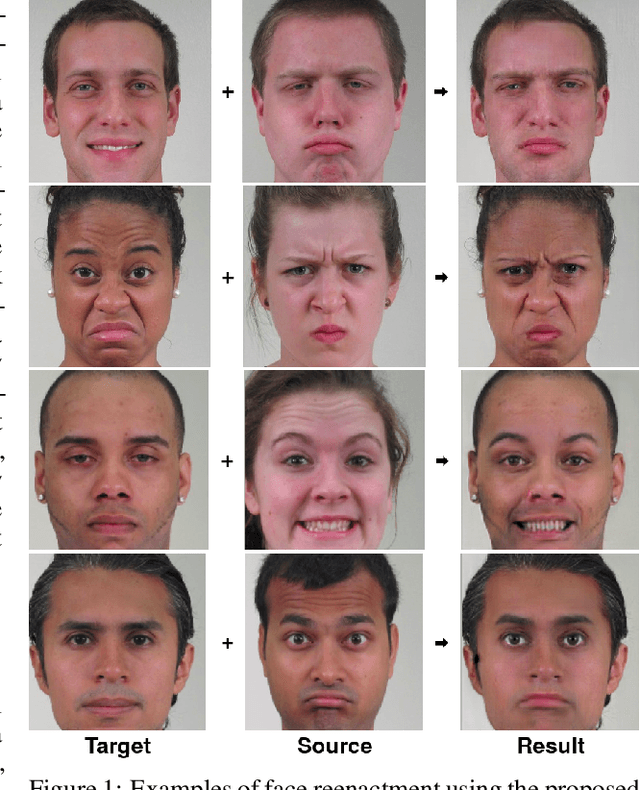
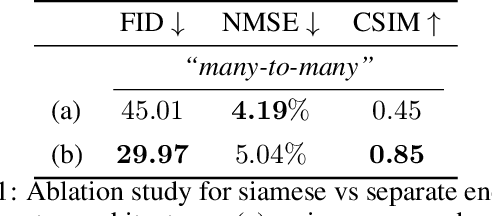

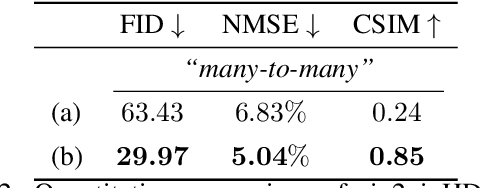
Abstract:This paper introduces ActGAN - a novel end-to-end generative adversarial network (GAN) for one-shot face reenactment. Given two images, the goal is to transfer the facial expression of the source actor onto a target person in a photo-realistic fashion. While existing methods require target identity to be predefined, we address this problem by introducing a "many-to-many" approach, which allows arbitrary persons both for source and target without additional retraining. To this end, we employ the Feature Pyramid Network (FPN) as a core generator building block - the first application of FPN in face reenactment, producing finer results. We also introduce a solution to preserve a person's identity between synthesized and target person by adopting the state-of-the-art approach in deep face recognition domain. The architecture readily supports reenactment in different scenarios: "many-to-many", "one-to-one", "one-to-another" in terms of expression accuracy, identity preservation, and overall image quality. We demonstrate that ActGAN achieves competitive performance against recent works concerning visual quality.
Fast and Efficient Model for Real-Time Tiger Detection In The Wild
Sep 03, 2019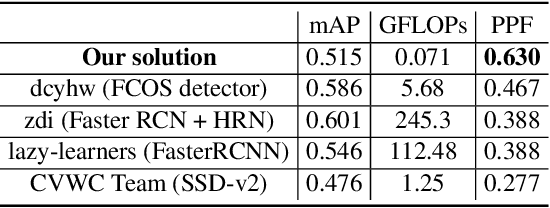
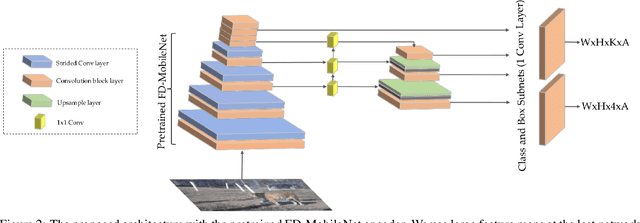
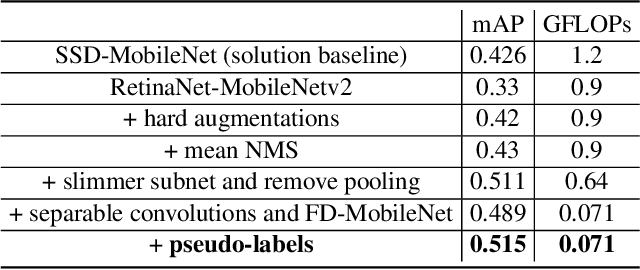

Abstract:The highest accuracy object detectors to date are based either on a two-stage approach such as Fast R-CNN or one-stage detectors such as Retina-Net or SSD with deep and complex backbones. In this paper we present TigerNet - simple yet efficient FPN based network architecture for Amur Tiger Detection in the wild. The model has 600k parameters, requires 0.071 GFLOPs per image and can run on the edge devices (smart cameras) in near real time. In addition, we introduce a two-stage semi-supervised learning via pseudo-labelling learning approach to distill the knowledge from the larger networks. For ATRW-ICCV 2019 tiger detection sub-challenge, based on public leaderboard score, our approach shows superior performance in comparison to other methods.
DeblurGAN-v2: Deblurring (Orders-of-Magnitude) Faster and Better
Aug 10, 2019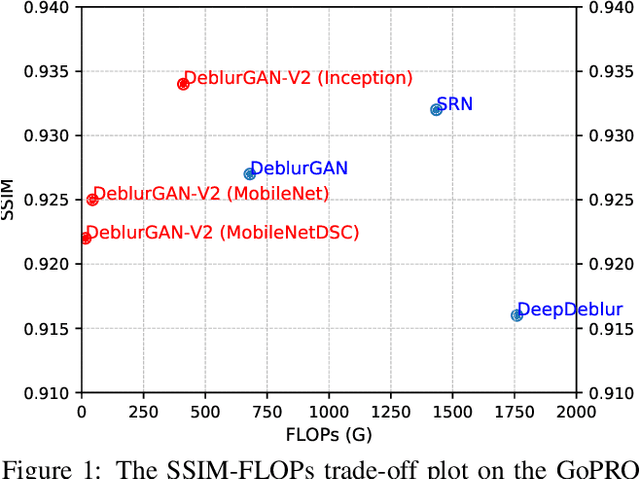



Abstract:We present a new end-to-end generative adversarial network (GAN) for single image motion deblurring, named DeblurGAN-v2, which considerably boosts state-of-the-art deblurring efficiency, quality, and flexibility. DeblurGAN-v2 is based on a relativistic conditional GAN with a double-scale discriminator. For the first time, we introduce the Feature Pyramid Network into deblurring, as a core building block in the generator of DeblurGAN-v2. It can flexibly work with a wide range of backbones, to navigate the balance between performance and efficiency. The plug-in of sophisticated backbones (e.g., Inception-ResNet-v2) can lead to solid state-of-the-art deblurring. Meanwhile, with light-weight backbones (e.g., MobileNet and its variants), DeblurGAN-v2 reaches 10-100 times faster than the nearest competitors, while maintaining close to state-of-the-art results, implying the option of real-time video deblurring. We demonstrate that DeblurGAN-v2 obtains very competitive performance on several popular benchmarks, in terms of deblurring quality (both objective and subjective), as well as efficiency. Besides, we show the architecture to be effective for general image restoration tasks too. Our codes, models and data are available at: https://github.com/KupynOrest/DeblurGANv2
Safe Augmentation: Learning Task-Specific Transformations from Data
Jul 30, 2019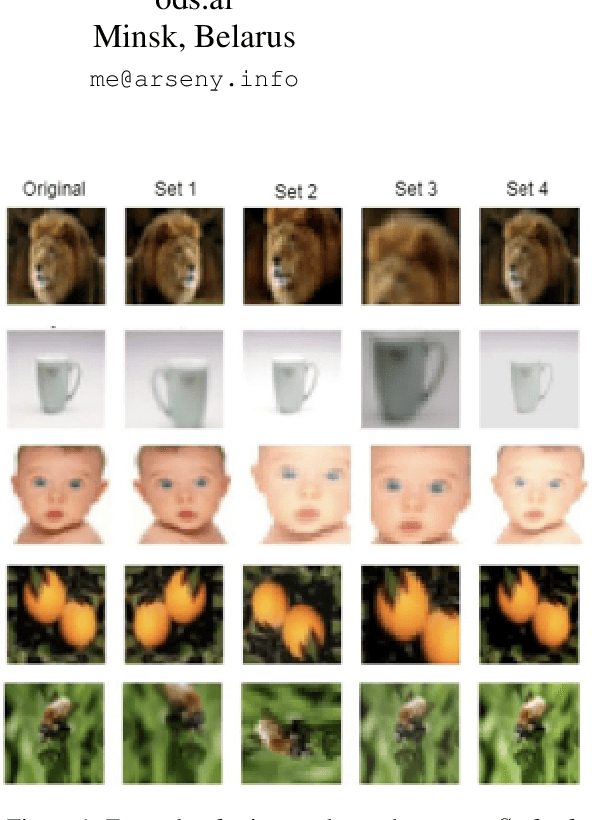
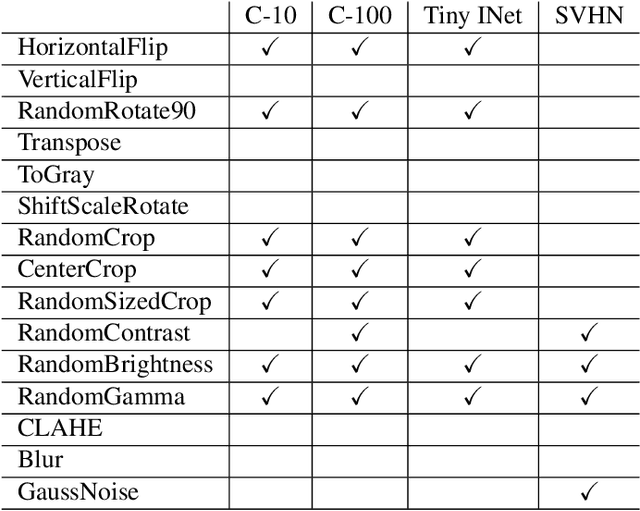
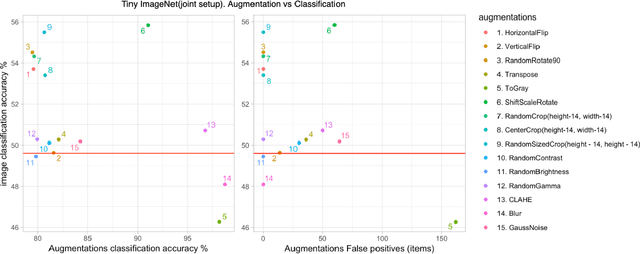

Abstract:Data augmentation is widely used as a part of the training process applied to deep learning models, especially in the computer vision domain. Currently, common data augmentation techniques are designed manually. Therefore they require expert knowledge and time. Moreover, augmentations are dataset-specific, and the optimal augmentations set on a specific dataset has limited transferability to others. We present a simple and explainable method called $\textbf{Safe Augmentation}$ that can learn task-specific data augmentation techniques that do not change the data distribution and improve the generalization of the model. We propose to use safe augmentation in two ways: for model fine-tuning and along with other augmentation techniques. Our method is model-agnostic, easy to implement, and achieves better accuracy on CIFAR-10, CIFAR-100, SVHN, Tiny ImageNet, and Cityscapes datasets comparing to baseline augmentation techniques. The code is available at $\href{https://github.com/Irynei/SafeAugmentation}{https://github.com/Irynei/SafeAugmentation}$.
 Add to Chrome
Add to Chrome Add to Firefox
Add to Firefox Add to Edge
Add to Edge